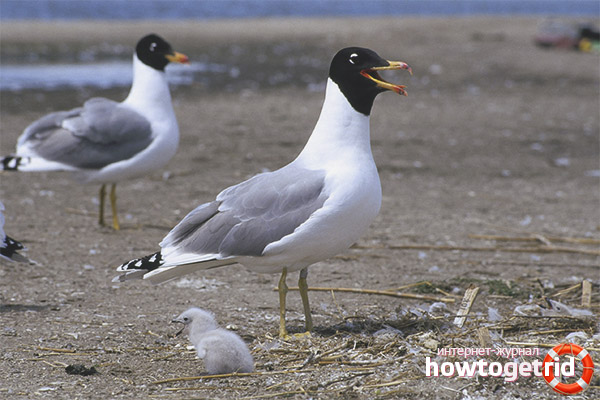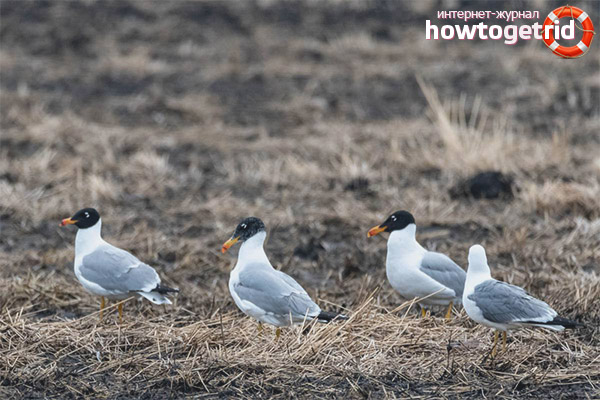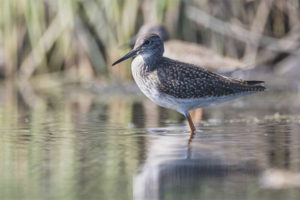The content of the article
Black-headed laughter is a large bird of the order of the charadriiformes of the gull family. Due to the critical reduction in the population, birds of this species are listed in the Red Book of Russia. On the Manych-Gudilo mineral lake, there is a Black Lands reserve, in which the laughter population is strongly supported and restored. The lake system of reservoirs in this area is protected by international conventions. In this article you will learn about what laughter is, why it has a similar name, where it lives and how it nests.
Description of black-headed laughter
Laughter is one of the largest gulls of the entire family. The average weight of a bird is about one and a half kilograms, length - 60 cm, wingspan can exceed one and a half meters. Recognizing a bird among other birds is quite simple - the head of a laughter has a shiny black color, the wings and upper back are smoky gray, the abdomen and chest are white. Beak - bright orange with black splashes. Sometimes it seems that the beak is simply tied with a black rope. This is a description of an adult mature bird. At a younger age, the black-headed laughter has no black head at all - he has gray or smoky. Sometimes this creates special problems in determining the species - it is difficult to identify the bird at a young age.
There are many legends around the name, although no one knows for certain why this silent bird was called laughter. Indeed, even in English, the name of the bird is translated as "a large black-headed gull." You can’t call a talkative laughter either - he only occasionally makes sounds remotely reminiscent of “Ha-ha-ha” or multiple “Au”. Perhaps, to some of the discoverers this seemed like laughter.
Black-headed laughter habitat
Black-headed laughter lifestyle
Black-headed laughter, like other types of gulls, flies beautifully, is able to soar in the air, only occasionally flapping its wings. On the water sits high, the bird does not dive to the depth. Laughter lives in colonies, quite numerous, in which up to 100 pairs of individuals. Sometimes other gull species are present in the colony. But they do not cross among themselves, birds always prefer partners of their own species. Black-headed laughter is very careful, almost never lets a person close. Most of the diet of laughter is fish - up to 70-80%. In addition to fish, the bird can enjoy insects, amphibians, small rodents and even chicks of other waterfowl. In most cases, the bird is settled, flies away for wintering only in case of freezing of the reservoir.
Blackhead nesting
Black-headed laughter reaches maturity in the fourth year of life. Birds also nest in large colonies so that often the distance between the nests does not exceed several meters. Often, laughter nests with silver gulls.Nesting sites are selected distant, without any vegetation, as a rule, these are rocky islands. Bird nests are built right on the ground, making small indentations on the shore. The vegetation is lined inside - underwater or ground. In the clutch there are usually about 2-3 eggs of a gray, swamp or brown color with a few interspersed. The female and the male incubate eggs in turn for 3-4 weeks, after which the chicks hatch one after another. Toddlers of the first days of life have a white fluff, which gradually turns gray. Chicks take to the wing after about a month and a half.
The black-headed laughter has poorly developed parental feelings. Birds often leave chicks to certain death only because they do not want to feed their babies and take care of them. Surprisingly, 80% of the chicks simply do not survive. Kids are susceptible to infection, they can become the prey of silver gulls, and relatives themselves often crush the chicks in general confusion and crowding. This is often observed in large colonies, when the density of nests is quite large. In birds of this species, the instinct of general care for the chicks is developed, which are combined in the so-called "kindergartens". That is, all the kids are gathered in a heap, adults do not divide them into friends and foes. Some of the birds fly away in search of food, another part remains to look after the baby and protect them from enemies. This allows you to give the viability of at least some part of the brood. On average, black-headed laughter live 15 years.
An interesting fact about the black-headed laughter
A few dozen years ago, laughing laughter was on the verge of extinction - this was facilitated by poor ecology, poaching, and egg collection. Today the situation has improved thanks to effective protective measures. Acting in the same spirit, humanity will nevertheless be able to maintain a population of black-headed laughter for future generations.
Video: black-headed laughter (Larus ichthyaetus)











Submit
I like this bird!